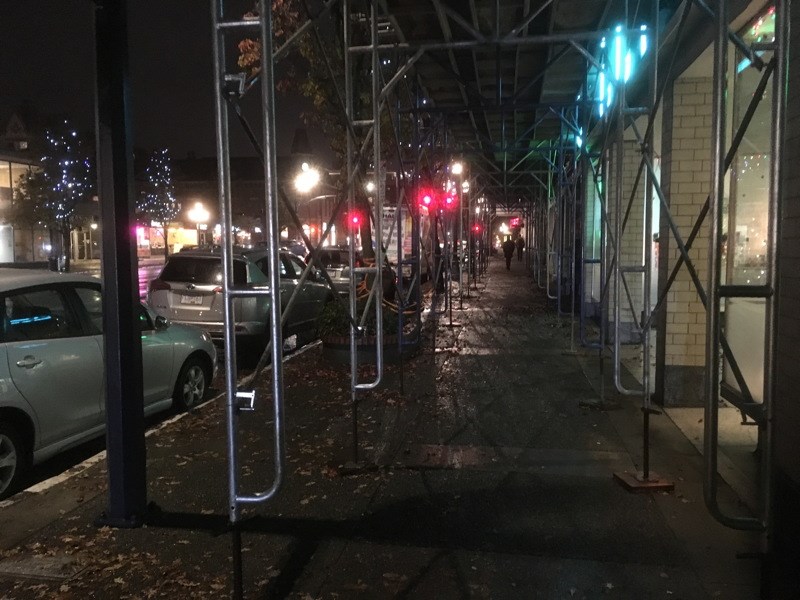A lot of people wear dark clothing on dark and rainy nights, courting disaster.
I’ve become a little obsessed about this after a few close calls. While driving at night, I almost hit a person who was dressed head to toe in black, barely seeing him as he strolled into my path. And, while I was a pedestrian, dressed in dark clothing, with nothing reflective, a car turning right came alarmingly close to me as I stepped onto a crosswalk.
In an informal survey of downtown pedestrians on three November nights, I found that a majority were in fashionable, death-defying black, with nothing reflective. But quite a few people, mostly women, were dressed for the darkness, with reflective bands on coat cuffs and bags, lighted straps, small lights, and a couple of reflective vests.
Since my close calls, I’ve stocked up on and am using reflective bands and wearable lights. I’ve offered reflective bands to colleagues and friends. Most have accepted, but a few declined, saying they’d never wear something like that. Too unfashionable.
That prompted me to look for alternatives.
It would be nice if the fashion industry incorporated reflective elements into more clothing. I looked around for a dark jacket with reflective stripes or dots that wasn’t designed for bicycling or running. There wasn’t much to pick from.
But you can come up with something satisfactory with a little tinkering, and still stick with your fashion fancies.
Among things I discovered, and re-discovered:
Life Paint, sold at Volvo dealerships for about $20 plus tax. You can spray it onto many non-shiny surfaces, such as a cloth coat or a pair of jeans, creating a reflective patch. The reflectiveness fades away with abrasion, and washes out in the laundry. I’ve tried it, and it works. Without direct light shining on it, the reflective patch looks slightly darker, like a hint of a grease stain. You might hesitate about spraying Life Paint onto a particularly expensive and cherished jacket, especially if it isn’t easily washed. Or, be like me, shrug, and go for it.
Relective yarn. You can buy yarn that’s reflective, and incorporate it into, say, a hat or a scarf. I haven’t done this, because I haven’t learned to knit yet. But a colleague says it works well and is a good look. I might commission a piece.
Brightly-coloured umbrellas. Carry something reflective or light-coloured, such as an umbrella. Umbrellas don’t have to be black. I bought one that’s lime green, and it’s quite visible in the semi-dark.
Reflective tape. Get reflective tape that has adhesive on one side. Stick it on the hem of a knock-about coat, on a shoulder bag, on luggage or an umbrella handle. Caution: the adhesive might become a problem, with the tape coming apart but the adhesive stubbornly staying. I found some for around $5 for a small roll.
Reflective bands. They’re usually a strip of reflective material that you form into a loop with velcro, a clip, or by tapping. I’m new to the tapping model, so I’m still fascinated: to put one on, start with the strip in its straight and rigid form, then tap against your wrist or ankle, and it rolls around your wrist or ankle. If you can’t bear to have a reflective band ruin your outfit, see if you can tolerate attaching one to your shoulder bag, backpack or suitcase. You can buy the reflective bands for about $2 (in volume) to $15 each.
Bands that light up. These are like the reflective bands, but they incorporate lighting along the band. $10 to $20 each.
Little lights. You can attach little lights to your clothing or to your bag. I’ve seen them for $6 to $30. There’s a caution here. Some people can’t tolerate these lights if they’re white and they blink. I can confirm that a flashing light can be irritating and maybe blinding, having followed cyclists (while cycling myself) with bright blinking lights. There can be trouble even when the blinking light is a more subdued red. So, consider just turning on the light and not have it blink.
“Turtle” lights are an example of the lights I’m talking about. They’re a couple inches long, an inch wide, and a half-inch thick. I’ve turned away from these lights this year because I'm annoyed about the coin batteries they use. The batteries are dangerous when swallowed, so young children shouldn’t use them. They also need frequent replacing in a process that can be fiddly, especially if tiny screws are involved. I’ve turned to slightly larger little lights that can be recharged via a cable or via a built-in USB plug.
The little lights project around 5 to 50 lumens of illumination. That’s enough to make you visible, but not enough for lighting your way while cycling on a pitch-black Galloping Goose trail. For that, you’ll need a light that’s at least 90 to 100 lumens; around 450 would be better. Packaging for lights typically list the lumens on offer.
But the lights are not useful if you can’t find a way to attach them to your clothing. I’ve had that problem with some of my jackets, which don’t have any loops for attaching things. That’s another lesson learned. The next time I buy a jacket, I’ll try to find one with a loop or two, and built-in reflective stripes.
Reflective shoes. You can attach reflectors to your shoes, though most athletic shoes for outdoor use come with reflective patches designed into them.
Headlamps. I’ve seen people wearing headlamps walking along downtown streets. I’m all for being visible, but I’m not sure if I’ve got the self-confidence to pull off a headlamp look.



